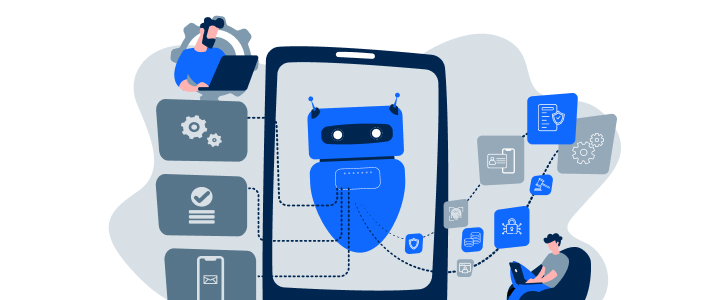From agents to factories: How the new AI reality is unfolding
Which topics and projects are currently at the top of your priority list?
Marc Stampfli: Basically, AI agents, digital twins of factories and their supply chains, active ingredient research and, more recently, humanoid robots are top of our agenda. We are also working across Europe to implement large AI factories — in other words data centers designed specially for AI applications.
What does your roadmap for Switzerland look like?
Marc Stampfli: Unfortunately, we can’t publish a formal roadmap. Several projects involving AI agents are currently underway with large companies in Switzerland. My personal goal would be to create a sovereign AI data center — a so-called AI factory — in Switzerland.
What do you see as the most important innovations we can expect from NVIDIA in the next 12 to 24 months?
Marc Stampfli: In the short term, the focus is clearly on AI agents. Many digital processes will soon be almost entirely automated. Every employee will work with a personal AI agent — comparable to a digital assistant. We will also see humanoid robots being produced in Switzerland. Scenarios such as independently disposing of a garbage bag or emptying a dishwasher are realistic in the medium term.
What are NVIDIA’s current priorities in terms of partnerships with local companies or the public sector in Switzerland?
Marc Stampfli: Local partnerships are essential for us — our partners understand the market conditions and are close to the customer. At the same time, they need to strategically realign themselves in the age of AI, as they often still lack in-depth expertise. We are also seeing a shift in thinking in the public sector: The public cloud is no longer the only option. Topics such as sovereign IT and sovereign AI are becoming increasingly relevant, driven by geopolitical uncertainties. Today, companies can operate large language models of comparable quality themselves — provided they have the necessary expertise. Those who rely solely on external services risk losing their competitive edge.
In the spring, you presented plans for humanoid robots at your developer con- ference. Can you briefly explain the plans? In which sectors and activities will robots take the lead in the coming years?
Marc Stampfli: We are pursuing the goal of making robots accessible for a wide range of tasks. Today, industrial robots are often confined to “cages” — we want to set them free. To achieve this, humanoid robots need more sensors and a precise physical world model. That is exactly what we are working on: a physical foundation model that gives robots a realistic understanding of their environment.
Your CEO Jensen Huang spoke of AI factories that will accelerate the development of robots. NVIDIA wants to cover all the building blocks: from training and testing the AI software to real-world deployment. With the help of digital twins, developers can run through multiple simulations in a short time and accelerate the implementation of AI applications.
Marc Stampfli: That’s right — AI agents and software development for robots require specialized data centers with optimized architecture. It is not enough to use traditional infrastructure. We are talking about specially designed systems with specific CPUs, GPUs, networks, and software — we call them AI factories. Building a data center of this kind in Switzerland in the style of European or American gigafactories would be a strategic milestone. It is not the size of a country that determines its innovative strength, but rather its access to this infrastructure.
How do you see Switzerland positioned in terms of adaptation of AI compared with other countries? Where do you see room for improvement?
Marc Stampfli: Switzerland is excellently positioned in terms of research — with world-leading professors and talents. What is lacking is the consistent development of our own AI factories to maintain this strength. Without these, we risk the best minds moving abroad. In addition, many boards of directors lack technical expertise in the field of AI. In my role, I am often in contact with these kinds of bodies, but there is rarely anyone to talk to about strategic AI issues. There is a clear need for action here.
Data centers around the world are switching to accelerated computing, and with your hardware platform you are a global leader in this field. With the NVIDIA AI Enterprise Software Stack, you also offer a software solution for developing and operating AI applications. How do you specifically support companies in implementing their AI strategy?
Marc Stampfli: We support companies in using our hardware and software as an integrated platform. NVIDIA AI Enterprise is a tool for this purpose — interoperability is key: in the cloud, on-premises or at the edge, with licensed as well as open-source models. Prompt engineering or native public cloud services alone are not enough for sustainable AI strategies. We also give companies strategic support, highlight industry-specific application options, and develop dedicated tools — for example for drug development, robotics, financial modeling, or physical simulation.
Marc Stampfli spoke about the relevance of AI agents. Projects in this area are also in high demand from our customers. What specific applications are we talking about here?
Pascal Wild: Our customers are increasingly relying on agents that coordinate tasks independently, interact with systems, and have contextual knowledge. In the financial sector, agents provide particular support in preparing for and following up on customer meetings: They analyze customer profiles, summarize relevant information, and automatically document the results of meetings. This significantly reduces the administrative workload. In the insurance world, they automatically classify and read unstructured documents such as dentist or pharmacy invoices and transfer them to internal processes. The use of agents is particularly relevant in public administration, where they deal with time-consuming routine tasks such as applications for ID cards, social security, or building permits. They combine existing data sources, identify missing information, and report it to the responsible parties. Depending on the level of digitalization, missing details are even automatically requested from the customer via email. This reduces the burden of repetitive data entry for both citizens and caseworkers, freeing up time for truly important tasks. Such solutions operate more dynamically when multiple specialized agents are orchestrated through a shared context — what is known as a multi-agent system: an extraction agent that gathers data from various sources, a validation agent that checks the data for plausibility, and another that initiates subsequent processes. This architecture enables flexible, modular, and scalable applications for dynamic and regulated business areas.
Software companies like ti&m are the link between big tech companies like NVIDIA and the Swiss economy. How do you see ti&m’s role as a local AI development and integration partner in the future?
Pascal Wild: Our task is to translate innovative technology into the local business context. As a link between platform providers such as NVIDIA and the Swiss economy, we combine technological excellence with a deep understanding of the industry. With our GenAI Toolbox, methodical expertise, and experience from projects in banking, insurance, and administration, we implement AI applications that are not only powerful, but also secure, scalable, and transparent.
Finally, what excites you most personally when it comes to the development of AI?
Marc Stampfli: What I personally find most exciting is learning about new, concrete applications for AI every day. My role gives me an insight into a wide variety of projects across all sectors. I find the advances in humanoid robots particularly fascinating at the moment. We are on the verge of a real technological leap forward in the near future. I live in an industry that is developing exponentially — that is extremely motivating, but also requires a lot of energy.
Pascal Wild: I am fascinated by how AI is developing from a tool for supporting decision- making to an intelligent partner in everyday working life. When agents are able to contribute to the thinking process, remember previous interactions, and act independently, this creates a whole new level of efficiency and intelligence.
ti&m Special “Swiss software and AI 2025”





